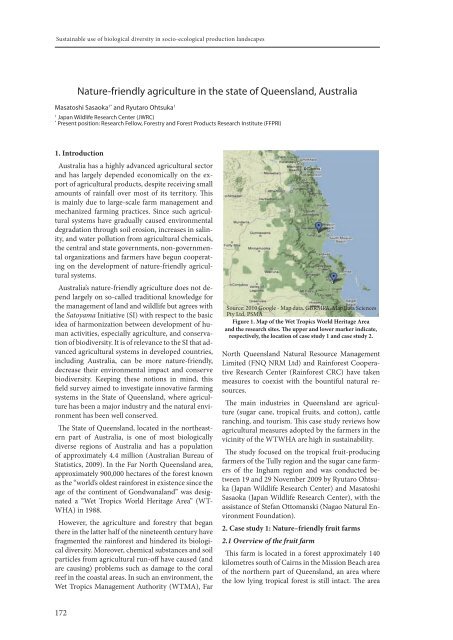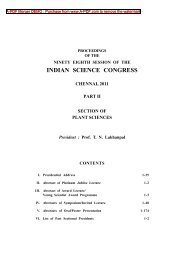sustainable use of biological diversity.pdf - India Environment Portal
sustainable use of biological diversity.pdf - India Environment Portal
sustainable use of biological diversity.pdf - India Environment Portal
You also want an ePaper? Increase the reach of your titles
YUMPU automatically turns print PDFs into web optimized ePapers that Google loves.
Sustainable <strong>use</strong> <strong>of</strong> <strong>biological</strong> <strong>diversity</strong> in socio-ecological production landscapes<br />
Nature-friendly agriculture in the state <strong>of</strong> Queensland, Australia<br />
Masatoshi Sasaoka 1* and Ryutaro Ohtsuka 1<br />
1<br />
Japan Wildlife Research Center (JWRC)<br />
*<br />
Present position: Research Fellow, Forestry and Forest Products Research Institute (FFPRI)<br />
1. introduction<br />
Australia has a highly advanced agricultural sector<br />
and has largely depended economically on the export<br />
<strong>of</strong> agricultural products, despite receiving small<br />
amounts <strong>of</strong> rainfall over most <strong>of</strong> its territory. This<br />
is mainly due to large-scale farm management and<br />
mechanized farming practices. Since such agricultural<br />
systems have gradually ca<strong>use</strong>d environmental<br />
degradation through soil erosion, increases in salinity,<br />
and water pollution from agricultural chemicals,<br />
the central and state governments, non-governmental<br />
organizations and farmers have begun cooperating<br />
on the development <strong>of</strong> nature-friendly agricultural<br />
systems.<br />
Australia’s nature-friendly agriculture does not depend<br />
largely on so-called traditional knowledge for<br />
the management <strong>of</strong> land and wildlife but agrees with<br />
the Satoyama Initiative (SI) with respect to the basic<br />
idea <strong>of</strong> harmonization between development <strong>of</strong> human<br />
activities, especially agriculture, and conservation<br />
<strong>of</strong> bio<strong>diversity</strong>. It is <strong>of</strong> relevance to the SI that advanced<br />
agricultural systems in developed countries,<br />
including Australia, can be more nature-friendly,<br />
decrease their environmental impact and conserve<br />
bio<strong>diversity</strong>. Keeping these notions in mind, this<br />
field survey aimed to investigate innovative farming<br />
systems in the State <strong>of</strong> Queensland, where agriculture<br />
has been a major industry and the natural environment<br />
has been well conserved.<br />
The State <strong>of</strong> Queensland, located in the northeastern<br />
part <strong>of</strong> Australia, is one <strong>of</strong> most <strong>biological</strong>ly<br />
diverse regions <strong>of</strong> Australia and has a population<br />
<strong>of</strong> approximately 4.4 million (Australian Bureau <strong>of</strong><br />
Statistics, 2009). In the Far North Queensland area,<br />
approximately 900,000 hectares <strong>of</strong> the forest known<br />
as the “world’s oldest rainforest in existence since the<br />
age <strong>of</strong> the continent <strong>of</strong> Gondwanaland” was designated<br />
a “Wet Tropics World Heritage Area” (WT-<br />
WHA) in 1988.<br />
However, the agriculture and forestry that began<br />
there in the latter half <strong>of</strong> the nineteenth century have<br />
fragmented the rainforest and hindered its <strong>biological</strong><br />
<strong>diversity</strong>. Moreover, chemical substances and soil<br />
particles from agricultural run-<strong>of</strong>f have ca<strong>use</strong>d (and<br />
are causing) problems such as damage to the coral<br />
reef in the coastal areas. In such an environment, the<br />
Wet Tropics Management Authority (WTMA), Far<br />
Source: 2010 Google - Map data. GBRMPA, MapData Sciences<br />
Pty Ltd, PSMA<br />
figure 1. Map <strong>of</strong> the Wet tropics World Heritage area<br />
and the research sites. The upper and lower marker indicate,<br />
respectively, the location <strong>of</strong> case study 1 and case study 2.<br />
North Queensland Natural Resource Management<br />
Limited (FNQ NRM Ltd) and Rainforest Cooperative<br />
Research Center (Rainforest CRC) have taken<br />
measures to coexist with the bountiful natural resources.<br />
The main industries in Queensland are agriculture<br />
(sugar cane, tropical fruits, and cotton), cattle<br />
ranching, and tourism. This case study reviews how<br />
agricultural measures adopted by the farmers in the<br />
vicinity <strong>of</strong> the WTWHA are high in sustainability.<br />
The study foc<strong>use</strong>d on the tropical fruit-producing<br />
farmers <strong>of</strong> the Tully region and the sugar cane farmers<br />
<strong>of</strong> the Ingham region and was conducted between<br />
19 and 29 November 2009 by Ryutaro Ohtsuka<br />
(Japan Wildlife Research Center) and Masatoshi<br />
Sasaoka (Japan Wildlife Research Center), with the<br />
assistance <strong>of</strong> Stefan Ottomanski (Nagao Natural <strong>Environment</strong><br />
Foundation).<br />
2. case study 1: nature–friendly fruit farms<br />
2.1 Overview <strong>of</strong> the fruit farm<br />
This farm is located in a forest approximately 140<br />
kilometres south <strong>of</strong> Cairns in the Mission Beach area<br />
<strong>of</strong> the northern part <strong>of</strong> Queensland, an area where<br />
the low lying tropical forest is still intact. The area<br />
172
















